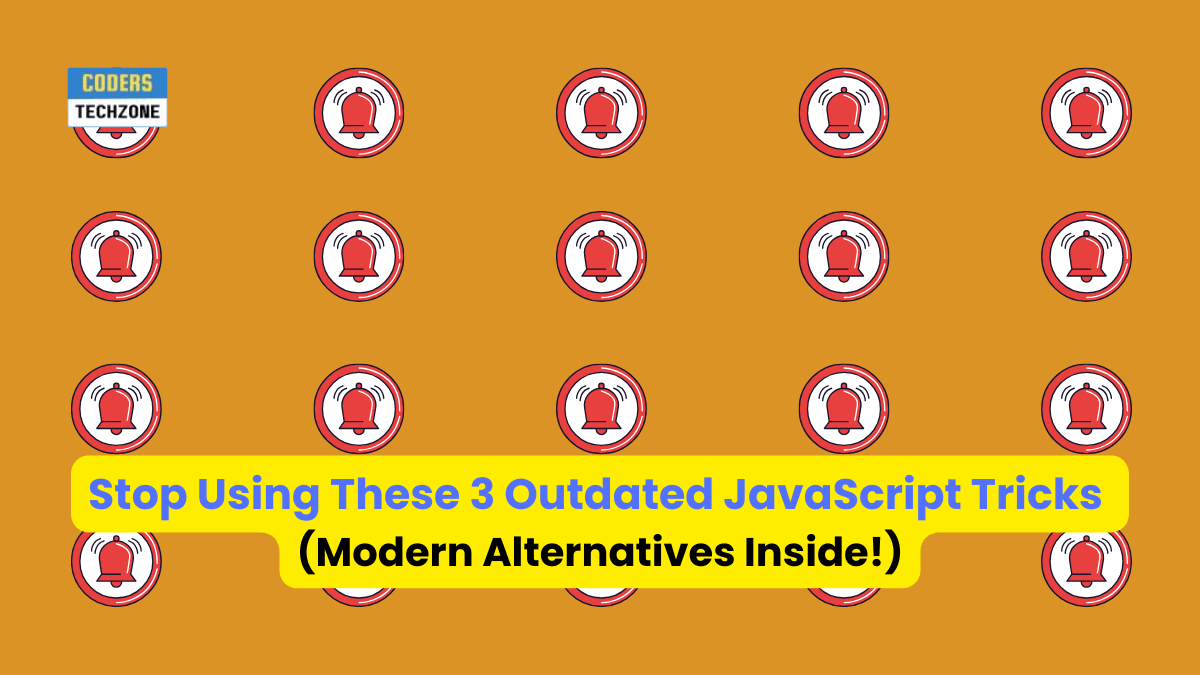JavaScript is improving, but many developers still use outdated techniques that slow down their code, create bugs and reduce readability. Are you using any of these old-school JavaScript tricks? Let’s check it.
In this article, I am showing you three outdated JavaScript practices that you should stop using today. Also going to share the JS tips and tricks with modern alternatives that helps you to improve performance as well. Let’s check without any delay!
🚫 Outdated Trick #1: Using var Instead of let or const
🔴 Why It’s Bad
varhas function scope, which can generate unexpected bugs.- You can re-declare, which increases the risk of re-assigning variables.
✅ Modern Alternative: Use let and const
// ❌ Outdated:
var name = "John";
var name = "Doe"; // No error, but risky!
// ✅ Modern:
let name = "John";
name = "Doe"; // Works fine
const age = 30;
age = 35; // ❌ TypeError: Assignment to constant variable✅ Known Differences: JS let vs const
| Feature | var | let | const |
|---|---|---|---|
| Scope | Function Scope: Only available inside the function where it’s declared. | Block Scope: Only available within the block (like loops, if statements). | Block Scope: Same as let, but the value cannot be reassigned. |
| Re-declaration | Can be re-declared: You can declare the same variable multiple times in the same scope. | Cannot be re-declared: Once declared, you can’t declare it again in the same block. | Cannot be re-declared: Same rule as let, but also can’t change its value. |
| Global Object Behavior | Becomes a property of the global object: In a browser, var declared globally becomes a property of the window object. | Does not become a global object property. | Does not become a global object property. |
| Best Use | Avoid in modern JavaScript: It can lead to bugs and confusion due to its function-scoped nature. | Use for variables that might change: Good for values you will modify later. | Use for constants: Best when the value should never change after initialization. |

🚫 Outdated Trick #2: Using == Instead of ===
🔴 Why It’s Bad
==allows type coercion, leading to unexpected results.- It’s hard-to-debug.
Difficult to understand? Let’s see through code examples.
console.log(0 == "0"); // true 😨 (unexpected)
console.log(false == ""); // true 😨✅ Modern Alternative: Use === for Strict Equality
console.log(0 === "0"); // false ✅ (expected result)
console.log(false === ""); // false ✅✅ Known Differences: Loose vs Strict Equality
| Feature | == (Loose Equality) | === (Strict Equality) |
|---|---|---|
| Comparison Type | Performs type coercion: It converts the values to the same type before comparing. | No type coercion: Both the value and the type must be the same. |
| Usage Scenario | Not recommended: It can lead to unexpected results, especially when comparing different types. | Recommended: Ensures you’re comparing both the type and the value accurately. |
| Example with Numbers & Strings | '5' == 5: This will return true because JavaScript converts '5' (string) to 5 (number). | '5' === 5: This will return false because the types (string and number) are different. |
| Performance | Slightly slower: Type coercion can take more time as it has to convert types before comparing. | Faster: No type conversion is needed, so it’s a more straightforward comparison. |
| Best Practice | Avoid: It can cause bugs or unexpected behavior when comparing values of different types. | Always use: It leads to fewer bugs and ensures the comparison is strict and accurate. |

🚫 Outdated Trick #3: Using for Loops Instead of forEach or map
🔴 Why It’s Bad
- Commonly used
forloops are verbose and error-prone. - It requires manual index management which increase complexities.
❌ Traditional JS For Loop
const numbers = [1, 2, 3];
for (let i = 0; i < numbers.length; i++) {
console.log(numbers[i]);
}✅ Modern Alternative: Use forEach or map
// ✅ Use forEach for iteration:
numbers.forEach(num => console.log(num));
// ✅ Use map for transformations:
const doubled = numbers.map(num => num * 2);
console.log(doubled); // [2, 4, 6] ✅✅ Known Differences: for Loops Instead of forEach or map
| Feature | for Loop | forEach | map |
|---|---|---|---|
| Syntax | Traditional: Requires explicit initialization, condition, and increment/decrement. | Cleaner: Shorter syntax for looping through arrays without manually handling index or condition. | Cleaner: Similar to forEach, but returns a new array with the results of the function. |
| Performance | Potentially faster: for loops can be faster, especially in large datasets, since there’s no additional function call overhead. | Slightly slower: Involves function calls, which can be a bit slower than a simple loop. | Slightly slower: Similar to forEach, as it also uses function calls to process each item. |
| Return Value | No return value: Simply iterates over the array without modifying or returning anything. | No return value: Executes the function on each item, but does not return a new array. | Returns a new array: Creates a new array with the values returned from the function applied to each item. |
| Best Use | Use for complex iterations: Great for complex logic where you need full control over the loop. | Use for simple operations: Best for running a function on each item, like logging or simple side effects. | Use for transforming arrays: Ideal when you want to apply a function to each item and return a new array. |

🎯 Conclusion
Modern JavaScript is designed to be faster, safer, and more efficient. Please do not use outdated tricks rather use these best practices, you’ll write better, cleaner, and more maintainable code.
👉 Which outdated JavaScript trick do you still see people using? Let me know in the comments! 🚀
🏋️♂️ Discover Code Blocks From 20+ yrs JS Expert
💥 Asp.net C# Developer
🏆 Solution Architect
👨✈️ Database Administrator
📢 Speaker
🎓 MCTS since 2009







Leave a Reply